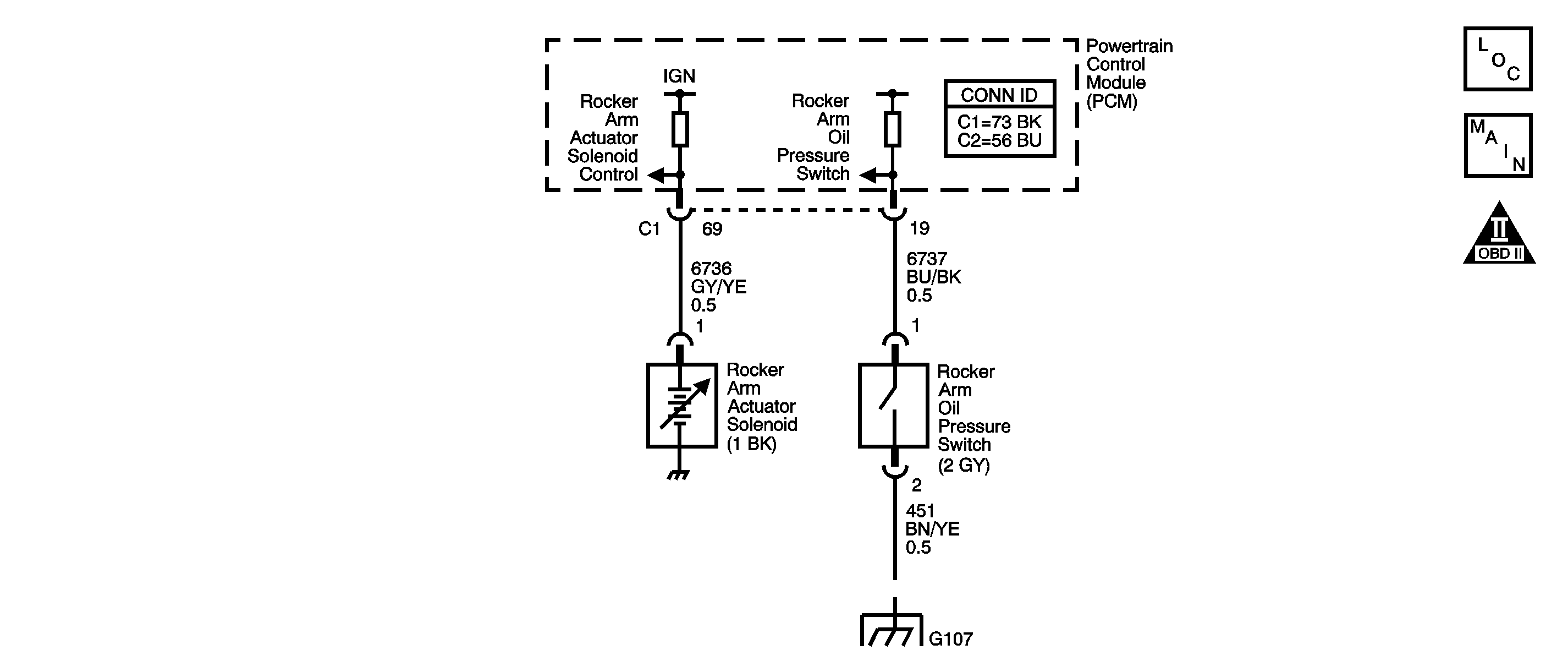
Circuit Description
The DTC P2649 Intake Rocker Arm Actuator Solenoid Control Circuit High Voltage diagnostic monitors the electrical circuit of the rocker arm oil control solenoid. The rocker arm oil control solenoid enables the powertrain control module (PCM) to operate the high speed cam system. The high speed cam system significantly increases valve lift at engine speeds above 4,400 RPM. A second camshaft lobe with a high lift profile is cast into each camshaft, alongside the low/medium speed lobes. Unique rocker arms follow both the high speed and low/medium speed cam lobes. At engine speeds below 4,400 RPM, the low/medium speed cam lobes operate the rocker arms. When the rocker arm oil control solenoid is turned ON between 4,400-6,500 RPM, the rocker arms are operated by the high speed cam lobes. The rocker arm oil control solenoid is energized by a 12-volt signal from the PCM. An open or a short to voltage in the solenoid control circuit will set a DTC P2649. For additional information on the operation of the rocker arm oil control system refer to Rocker Arm Oil Control System Description .
DTC Descriptors
This diagnostic procedure supports the following DTC.
DTC P2649 Intake Rocker Arm Actuator Solenoid Control Circuit High Voltage
Conditions for Running the DTC
| • | Before the PCM can report DTC P2649 failed, DTC P0325 must run and pass. |
| • | Battery voltage is at least 10.1 volts |
| • | The ignition is ON. |
| • | DTC P2649 runs continuously once the above conditions are met. |
Conditions for Setting the DTC
| • | The control circuit of the rocker arm oil control solenoid is high when the solenoid is OFF. |
| • | The above condition is present for at least 1.2 seconds. |
Action Taken When the DTC Sets
| • | The PCM illuminates the malfunction indicator lamp (MIL). |
| • | The PCM stores the conditions that were present when the DTC set as Freeze Frame data. |
Conditions for Clearing the MIL/DTC
| • | The PCM turns OFF the MIL on the third consecutive trip cycle during which the diagnostic has been run and the fault condition is no longer present. |
| • | A DTC clears after 40 consecutive warm-up cycles have occurred without a fault. |
| • | A DTC can be cleared by using the scan tool Clear DTC Information function. |
Test Description
The numbers below refer to the step numbers in the diagnostic table.
-
The Diagnostic System Check-Engine Controls prompts the technician to complete some basic checks and store the Freeze Frame data on the scan tool if applicable. This creates an electronic copy of the data taken when the fault occurred. The information is then stored in the scan tool for later reference.
-
This step checks the operation of the rocker arm oil control solenoid. With the oil control solenoid energized oil pressure will open the switch and the scan tool should indicate ON.
-
This step checks for an open in the rocker arm oil control solenoid circuit. The PCM provides a 12 volt bias signal on the solenoid control circuit that is pulled low when the solenoid is OK and has a good ground.
-
This step determines whether the PCM can send the command to operate the the rocker arm oil control solenoid. All rocker arm oil conrtol system DTCs must be cleared in order to command the solenoid ON with the scan tool. The PCM provides a 12 volt bias signal on the solenoid control circuit that is pulled low when the solenoid is OK and has a good ground.
-
After replacing the PCM, a new minimum throttle position and idle speed must also be established.
Step | Action | Values | Yes | No |
|---|---|---|---|---|
Connector End View Reference: Powertrain Control Module Connector End Views or Engine Controls Connector End Views | ||||
Did you perform the Diagnostic System Check-Engine Controls? | -- | Go to Step 2 | ||
2 |
Is DTC P2649 set? | -- | Go to Step 4 | Go to Step 3 |
Did the oil pressure switch indicate ON when the solenoid was commanded ON and OFF when the solenoid was commanded OFF? | -- | Go to Intermittent Conditions | Go to Step 4 | |
4 |
Is the resistance within the specified range? | 14-30 ohms at 20°C (68°F) | Go to Step 5 | Go to Step 9 |
Is the voltage near the specified value? | 12 V | Go to Step 6 | Go to Step 7 | |
Did the test lamp illuminate when the solenoid was commanded ON with the scan tool? | -- | Go to Step 8 | Go to Step 11 | |
7 |
Was a repair necessary? | -- | Go to Step 12 | Go to Step 10 |
8 | Locate and repair the poor electrical connection or poor ground to the rocker arm solenoid. Refer to Wiring Repairs in Wiring Systems. Did you complete the repair? | -- | Go to Step 12 | -- |
9 | Replace the rocker arm oil control solenoid. Refer to Rocker Arm Oil Control Solenoid Valve Replacement . Is the action complete? | -- | Go to Step 12 | -- |
10 |
Was a repair necessary? | -- | Go to Step 12 | Go to Step 11 |
Did you complete the replacement? | -- | Go to Step 12 | -- | |
12 |
Does the DTC run and pass? | -- | Go to Step 13 | Go to Step 2 |
13 | With a scan tool, observe the stored information, Capture Info. Does the scan tool display any DTCs that you have not diagnosed? | -- | System OK | |
